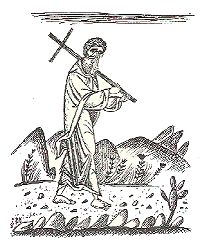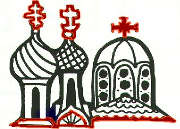Orthodoxy and Western Christianity: For Roman Catholics
An Orthodox View of the Great Schism, an excerpt from The Orthodox Church, by Bishop Kallistos (Ware).
Why Orthodoxy Is the True Faith. A lecture by A.I.Osipov on the Fundamentals of Theology, held in the Sretenskaya Theological Seminary on September 13, 2000.
Papal Monarchy— Collegial Traditions. An excerpt from Chapter 1 of Two Paths.

Notes on the Palamite Controversy and Related Topics, by Fr. John Romanides (In two parts from The Greek Orthodox Theological Review, Vol. VI [Winter 1960-61] and Vol. IX [Winter 1963-64]). In these two devastatingly brilliant and lengthy articles, the author reviews A Study of Gregory Palamas by Fr. John Meyendorff. He demonstrates that Meyendorff's understanding of this venerable defender of Hesychasm was seriously flawed on a number of fronts. There are a number of excellent points made along the way showing the big differences between the Orthodox and Latin understanding of the spiritual life.
Encyclical of the Eastern Patriarchs (1848): A Reply to the Epistle of Pope Pius IX, "to the Easterns."
Patriarchal Encyclical of 1895: A Reply to the Papal Encyclical of Pope Leo XIII (1895) on Reunion.
The Vatican Dogma, by Sergius Bulgakov.
The Marian Apparitions: Divine Intervention or Delusion?, by Mirian Lambouras. This is a lengthy essay (30+ pages) surveying Marian apparitions in the Roman Catholic Church. Mrs. Lambouras took up this research project after discovering that many Orthodox Christians have come to accept these apparitions as being from God. She was alarmed to learn that so many are making pilgrimages to these sites.
Journey to Medjugorje, by Matushka Katherine Swanson. The wife of a Russian Orthodox Church Abroad Priest reports on her trip to this Roman Catholic Marian shrine.
A "New Mary" for a New Age?, by Peter Jackson.
A Comparison of the Mysticism of Francis of Assisi with that of St. Seraphim of Sarov. From the Orthodox periodical Synaxis.
Papism as the Oldest Protestantism: by the Blessed Father Justin (Popovich)
Why I Abandoned Papism, by Hierodeacon Paul Ballaster-Convolier.
Orthodox Traditionalism vs. Roman Catholic Traditionalism: a Q&A from Orthodox Tradition discussing the differences between Orthodox and Roman Catholic ecclesiology.
The Vatican and Russia, by Deacon Herman Ivanov-Treenadzaty. This article is very favorably cited by Hieromonk Patapios Hagiogregorites in a forthcoming article for Orthodox Tradition which touches on the Uniate problem. Appended to it is a short article on Josaphat the Malevolent, considered a Saint by the Roman Catholics.
St. Mark of Ephesus on the State of Souls After Death: Against the Roman Catholic Doctrine of Purgatory. Excerpts from his homilies given at the 15th century Pseudo-Synod of Ferrara-Florence.
The Tragedy of Our Uniate Brothers, by Hieromonk [now Bishop] Auxentios
The False Decretals of Isidore, An excerpt from The Papacy, by Abbe Guette. "The False Decretals make as it were the dividing point between the Papacy of the first eight and that of the succeeding centuries. At this date, the pretensions of the Popes begin to develop and take each day a more distinct character."
Papal Supremacy: an Orthodox Tradition Q&A.
Papal Infallibility Becomes Dogma, an excerpt from Two Paths, by Michael Whelton.
Recommended Books

Bishop [now Archbishop] Chrysostomos of Oreoi [now of Etna] and Hieromonk[now Bishop] Auxentios, The Roman West and the Byzantine East. Etna, CA: Center for Traditionalist Orthodox Studies, 1988. A superb, short treatment of general differences between East and West. "This little book takes us back to the quest for truth and tells us why we Orthodox believe that our Church is true to the Church established by the Apostles, why she has historical and spiritual primacy. It does so by pointing out differences and by the bold proclamation of Orthodoxy's uniqueness." [from the back cover]. Also, I cannot resist including this excerpt from p. 10: "All history, one might say, is artificial... The Western view of the Christian past, however, is particularly artificial—it is a rather a "whopping lie," as the modern idiom would have it, if only because it ignores the historical experience of more than half of the Christian world, the Christian East, from which Western Christianity itself derives! Yet, it has gained such ascendancy that one is hesitant to challenge it. It is so ubiquitous that even Eastern Christians, especially those living in the West, often embrace it themselves. And if they do not, in fact, embrace it as their personal view, they often feel compelled to speak within its framework in trying to present their own perspectives on the Christian past. The Western view has, indeed, become triumphant, despite its inadequacies in accounting, as we shall see, for a vast part of Christian history."
The Primacy of Peter: Essays in Ecclesiology and the Early Church, by John Meyendorff (ed.). In considering the issue which has divided Christians in the past and still divides them today, a group of Orthodox theologians from different theological perspectives reflect upon the scriptural passages which single out Peter among the disciples of Jesus. Koulomzine ("Peter's Place in the Primitive Church") and Kesich ("Peter's Primacy in the New Testament and the Early Tradition"), as exegetes, read the passages in the light of contemporary New Testament research. Fr. John Meyendorff ("St Peter in Byzantine Theology") looks at the history of exegesis: how were these passages read at the time when East and West split, quarrelling about the issue of authority in the Church? Finally, Schmemann ("The Idea of Primacy in Orthodox Ecclesiology") and Afanassieff ("The Church Which Presides in Love") look at the meaning of "primacy" as a permanent, through changing, factor of "catholic" ecclesiology.
Orthodox and Roman Catholic Relations from the Fourth Crusade to the Hesychastic Controversy, by Archbishop Chrysostomos, Senior Fulbright Lecturer, Faculty of History, University of Bucharest, Romania.
Carlton, Clark, The Truth: What Every Roman Catholic Should Know About the Orthodox Church. Salisbury, MA: Regina Orthodox Press, 1998. Well written and researched, this book takes a firm Orthodox stance concerning Roman Catholicism. The author succinctly and clearly explains the issues that separate the Roman Catholics from the Orthodox Church. There is one fairly serious omission worth noting. On p. 86, footnote 18, Mr. Carlton refers the reader to Fr. John Meyendorff's A Study of St. Gregory Palamas for a more in-depth treatment of the 14th-century Palamite Controversy. The reader should know that Fr. John's study is seriously flawed to the point of being wholly misleading, if not worthless. This was forcefully and thoroughly demonstrated by Fr. John Romanides in his masterful two-part review of A Study (The Greek Orthodox Theological Review, Vol. VI [Winter 1960-61] and Vol. IX [Winter 1963-64]).
de Ballester, Bishop Paul, My Exodus from Roman Catholicism: his long and painstaking journey from being a Roman Catholic monk in Spain to a Orthodox Christian bishop in Mexico, where he was assassinated in 1984.
Guette, Abbe, The Papacy: Its Historic Origin and Primitive Relations with the Eastern Church [PDF, 1.4 megs]. New York: Minos Publishing Company, 1866. Though this is an old book, it has seen numerous reprints and can still be found with a little searching. It is the most thorough and reliable treatment of the Papacy from an Orthodox position.
The Lives of the Pillars of Orthodoxy. Buena Vista, CO: Holy Apostles Convent and the Dormition Skete, 1990. Contains the lives of Saints Photios the Great (9th century), Mark of Ephesus (15th century), and St. Gregory Palamas (14th century), three Saints who are especially noted for their opposition to Latin theology. Differences between East and West are covered in depth.
Ostroumoff, Ivan, The History of the Council of Florence. Boston, MA: Holy Transfiguration Monastery, 1971. This was a Pseudo-Synod in the mid-15th century which was chiefly opposed through the efforts of St. Mark of Ephesus. The book is very detailed, but quite an enjoyable read. Numerous differences between Latin and Orthodox theology are treated in detail.
Photios the Great, Saint, On the Mystagogy of the Holy Spirit. Studion Publishers, Inc., 1983. Aside from a superb English translation of St. Photios' Mystagogy, this book also includes the Synodicon on the Holy Spirit, "St. Photios and the Filioque" by Michael Azkoul, and "The Life of St. Photios" by St. Justin Popovich. These are all key works dealing with critical issues that divide Orthodoxy from Roman Catholicism. Those who think that the issue over the Filioque is "just a matter of semantics" or "not that big a deal" will be sorely challenged by this book.
Welton, Michael, Two Paths: Papal Monarch—Collegial Tradition. Salisbury, MA: Regina Orthodox Press, 1998. From their website: "[C]ompassionately, simply, and factually explains the historic, theological, and liturgical differences between the Orthodox and Roman Catholic traditions."

